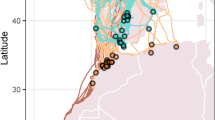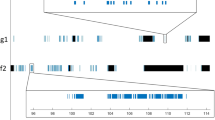Abstract
Speed is the fundamental constraint on animal movement, yet there is no general consensus on the determinants of maximum speed itself. Here, we provide a general scaling model of maximum speed with body mass, which holds across locomotion modes, ecosystem types and taxonomic groups. In contrast to traditional power-law scaling, we predict a hump-shaped relationship resulting from a finite acceleration time for animals, which explains why the largest animals are not the fastest. This model is strongly supported by extensive empirical data (474 species, with body masses ranging from 30 μg to 100 tonnes) from terrestrial as well as aquatic ecosystems. Our approach unravels a fundamental constraint on the upper limit of animal movement, thus enabling a better understanding of realized movement patterns in nature and their multifold ecological consequences.
This is a preview of subscription content, access via your institution
Access options
Access Nature and 54 other Nature Portfolio journals
Get Nature+, our best-value online-access subscription
$29.99 / 30 days
cancel any time
Subscribe to this journal
Receive 12 digital issues and online access to articles
$119.00 per year
only $9.92 per issue
Buy this article
- Purchase on Springer Link
- Instant access to full article PDF
Prices may be subject to local taxes which are calculated during checkout




Similar content being viewed by others
References
Jetz, W., Carbone, C., Fulford, J. & Brown, J. H. The scaling of animal space use. Science 306, 266–268 (2004).
Bauer, S. & Hoye, B. J. Migratory animals couple biodiversity and ecosystem functioning worldwide. Science 344, 1242552 (2014).
Parmesan, C. & Yohe, G. A globally coherent fingerprint of climate change impacts across natural systems. Nature 421, 37–42 (2003).
Pawar, S., Dell, A. I. & Savage, V. M. Dimensionality of consumer search space drives trophic interaction strengths. Nature 486, 485–489 (2012).
Neutel, A.-M. et al. Reconciling complexity with stability in naturally assembling food webs. Nature 449, 599–602 (2007).
Kays, R., Crofoot, M. C., Jetz, W. & Wikelski, M. Terrestrial animal tracking as an eye on life and planet. Science 348, aaa2478 (2015).
Hussey, N. E. et al. Aquatic animal telemetry: a panoramic window into the underwater world. Science 348, 1255642 (2015).
Peters, R. H. The Ecological Implications of Body Size (Cambridge Univ. Press, 1983).
Hedenström, A. Scaling migration speed in animals that run, swim and fly. J. Zool. 259, 155–160 (2003).
Bejan, A. & Marden, J. H. Unifying constructal theory for scale effects in running, swimming and flying. J. Exp. Biol. 209, 238–248 (2006).
Iriarte-Díaz, J. Differential scaling of locomotor performance in small and large terrestrial mammals. J. Exp. Biol. 205, 2897–2908 (2002).
Fuentes, M. A. Theoretical considerations on maximum running speeds for large and small animals. J. Theor. Biol. 390, 127–135 (2016).
Garland, T. The relation between maximal running speed and body mass in terrestrial mammals. J. Zool. 199, 157–170 (1983).
Clemente, C. J. & Richards, C. Muscle function and hydrodynamics limit power and speed in swimming frogs. Nat. Commun. 4, 2737 (2013).
Clemente, C. J., Thompson, G. G. & Withers, P. C. Evolutionary relationships of sprint speed in Australian varanid lizards. J. Zool. 278, 270–280 (2009).
Van Damme, R. & Vanhooydonck, B. Origins of interspecific variation in lizard sprint capacity. Funct. Ecol. 15, 186–202 (2001).
Dick, T. J. & Clemente, C. J. Where have all the giants gone? How animals deal with the problem of size. PLoS Biol. 15, e2000473 (2017).
Clemente, C. J., Withers, P. C. & Thompson, G. Optimal body size with respect to maximal speed for the yellow-spotted monitor lizard (Varanus panoptes; Varanidae). Physiol. Biochem. Zool. 85, 265–273 (2012).
Alexander, R. M. Principles of Animal Locomotion (Princeton Univ. Press, 2003).
Huey, R. B. & Hertz, P. E. Effects of body size and slope on acceleration of a lizard (Stellio stellio). J. Exp. Biol. 110, 113–123 (1984).
Elliott, J. P., Cowan, I. M. & Holling, C. S. Prey capture by the African lion. Can. J. Zool. 55, 1811–1828 (1977).
Garcia, G. J. & da Silva, J. K. On the scaling of mammalian long bones. J. Exp. Biol. 207, 1577–1584 (2004).
Biewener, A. A. Biomechanical consequences of scaling. J. Exp. Biol. 208, 1665–1676 (2005).
Jones, J. H. & Lindstedt, S. L. Limits to maximal performance. Annu. Rev. Physiol. 55, 547–569 (1993).
Weyand, P. G. & Bundle, M. W. Energetics of high-speed running: integrating classical theory and contemporary observations. Am. J. Physiol. Regul. Integr. Comp. Physiol. 288, R956–R965 (2005).
Pollock, C. M. & Shadwick, R. E. Allometry of muscle, tendon, and elastic energy storage capacity in mammals. Am. J. Physiol. Regul. Integr. Comp. Physiol. 266, R1022–R1031 (1994).
Alexander, Rm, Jayes, A. S., Maloiy, G. M. O. & Wathuta, E. M. Allometry of the leg muscles of mammals. J. Zool. 194, 539–552 (1981).
Bennett, M. B. Allometry of the leg muscles of birds. J. Zool. 238, 435–443 (1996).
Maloiy, G. M. O., Alexander, R., Njau, R. & Jayes, A. S. Allometry of the legs of running birds. J. Zool. 187, 161–167 (1979).
Comparative Physiology: Life in Water and on Land (eds Dejours, P. et al.) (FIDIA Research Series Vol. 9, Springer, 1987).
Gillooly, J. F., Brown, J. H., West, G. B., Savage, V. M. & Charnov, E. L. Effects of size and temperature on metabolic rate. Science 293, 2248–2251 (2001).
Williams, T. M. The evolution of cost efficient swimming in marine mammals: limits to energetic optimization. Phil. Trans. R. Soc. Lond. B Biol. Sci. 354, 193–201 (1999).
Biewener, A. A. Bone strength in small mammals and bipedal birds: do safety factors change with body size? J. Exp. Biol. 98, 289–301 (1982).
Blanco, R. E. & Jones, W. W. Terror birds on the run: a mechanical model to estimate its maximum running speed. Proc. R. Soc. B Biol. Sci. 272, 1769–1773 (2005).
Thulborn, R. A. Speeds and gaits of dinosaurs. Palaeogeogr. Palaeoclimatol. Palaeoecol. 38, 227–256 (1982).
Sellers, W. I. & Manning, P. L. Estimating dinosaur maximum running speeds using evolutionary robotics. Proc. R. Soc. Lond. B Biol. Sci. 274, 2711–2716 (2007).
Hutchinson, J. R. & Garcia, M. Tyrannosaurus was not a fast runner. Nature 415, 1018–1021 (2002).
Brown, J. H., Gillooly, J. F., Allen, A. P., Savage, V. M. & West, G. B. Toward a metabolic theory of ecology. Ecology 85, 1771–1789 (2004).
Rall, B. C. et al. Universal temperature and body-mass scaling of feeding rates. Phil. Trans. R. Soc. Lond. B Biol. Sci. 367, 2923–2934 (2012).
Dell, A. I., Pawar, S. & Savage, V. M. Systematic variation in the temperature dependence of physiological and ecological traits. Proc. Natl Acad. Sci. USA 108, 10591–10596 (2011).
Tamburello, N., Côté, I. M. & Dulvy, N. K. Energy and the scaling of animal space use. Am. Nat. 186, 196–211 (2015).
Carbone, C., Cowlishaw, G., Isaac, N. J. B. & Rowcliffe, J. M. How far do animals go? Determinants of day range in mammals. Am. Nat. 165, 290–297 (2005).
Hein, A. M., Hou, C. & Gillooly, J. F. Energetic and biomechanical constraints on animal migration distance. Ecol. Lett. 15, 104–110 (2012).
R Core Team. R: A Language and Environment for Statistical Computing (R Foundation for Statistical Computing, 2015).
Freckleton, R. P. On the misuse of residuals in ecology: regression of residuals vs. multiple regression. J. Anim. Ecol. 71, 542–545 (2002).
Acknowledgements
M.R.H., W.J., B.C.R. and U.B. acknowledge the support of the German Centre for integrative Biodiversity Research (iDiv) Halle-Jena-Leipzig funded by the German Research Foundation (FZT 118).
Author information
Authors and Affiliations
Contributions
M.R.H. and U.B. developed the model. M.R.H. gathered the data. M.R.H. and B.C.R. carried out statistical analyses. W.J. was involved in study concept and data analyses. M.R.H. and U.B. wrote the paper. All authors discussed the results and commented on the manuscript.
Corresponding author
Ethics declarations
Competing interests
The authors declare no competing financial interests.
Additional information
Publisher’s note: Springer Nature remains neutral with regard to jurisdictional claims in published maps and institutional affiliations.
Electronic supplementary material
Supplementary information
Supplementary Tables 1–5; maximum speed database
Rights and permissions
About this article
Cite this article
Hirt, M.R., Jetz, W., Rall, B.C. et al. A general scaling law reveals why the largest animals are not the fastest. Nat Ecol Evol 1, 1116–1122 (2017). https://doi.org/10.1038/s41559-017-0241-4
Received:
Accepted:
Published:
Issue Date:
DOI: https://doi.org/10.1038/s41559-017-0241-4
This article is cited by
-
Dynamic similarity and the peculiar allometry of maximum running speed
Nature Communications (2024)
-
Predicting movement speed of beetles from body size and temperature
Movement Ecology (2023)
-
Locomotion rhythm makes power and speed
Scientific Reports (2023)
-
Scaling the tail beat frequency and swimming speed in underwater undulatory swimming
Nature Communications (2023)
-
Conceptual and empirical bridges between micro- and macroevolution
Nature Ecology & Evolution (2023)



